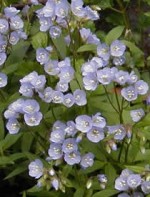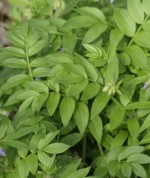 The lovely light blue flowers create a magic moment in late spring for a couple of weeks when the foliage takes over and provides the main interest. The leaves are pinnately compound in such a way that they look like the rungs of a ladder, giving the plant its common name. Although the specific name suggests that the plant is a rampant spreader it is not and spreads by seeds to form an attractive ground cover over time. Breeding programs have produced cultivars that are less floppy and that have variegated leaves. A native of moist woods in the northeast and the prairies, it thrives in moist condition but tolerates some drought. If dry conditions persist it may go dormant but will return.
The lovely light blue flowers create a magic moment in late spring for a couple of weeks when the foliage takes over and provides the main interest. The leaves are pinnately compound in such a way that they look like the rungs of a ladder, giving the plant its common name. Although the specific name suggests that the plant is a rampant spreader it is not and spreads by seeds to form an attractive ground cover over time. Breeding programs have produced cultivars that are less floppy and that have variegated leaves. A native of moist woods in the northeast and the prairies, it thrives in moist condition but tolerates some drought. If dry conditions persist it may go dormant but will return.
Type: Herbaceous perennial
Bloom: Light blue nodding flowers are 2/3” across and have long stamens with white anthers; borne in loose clusters for about two weeks in late spring.
 Foliage: Pinnately compound leaves up to one foot long have 5-15 oval leaflets with smooth margins.
Foliage: Pinnately compound leaves up to one foot long have 5-15 oval leaflets with smooth margins.
Size: 8-18″ H x 12″ W
Light: Part sun to part shade
Soil: Fertile, humus rich, moist to average, well-drained
Fertilizer: Apply fertilizer or compost in spring
Hardiness: Zones 3-8 but does not like hot humid weather
Care: Remove dead foliage in spring; deadhead to prolong bloom
Pests and Diseases: None of significance but susceptible to a variety of fungal infections.
Propagation: Seed (ripen in late summer); division in fall or spring
Outstanding selections:
var. alba (white flowers)
‘Blue Pearl (8-10″, bright blue flowrs)
‘Touch of Class’ (variegated, light blue flowers)
Companion plants: Trillium (Trillium spp.), wild ginger (Asarum canadense), shooting star (Dodecatheon meadia), large flowered bellwort (Uvularia gradiflora), Solomon’s seal (Polygonatum biflorum), wild geranium (Geranium maculatum), Jack-on-the-pulpit (Asisaema triphyllum), sharp-lobed hepatica (Hepatica acutiloba), spiderwort (Tradescantia virginiana), columbine (Aquilegia formosa), Christmas fern (Polystichum acrostichoides).
